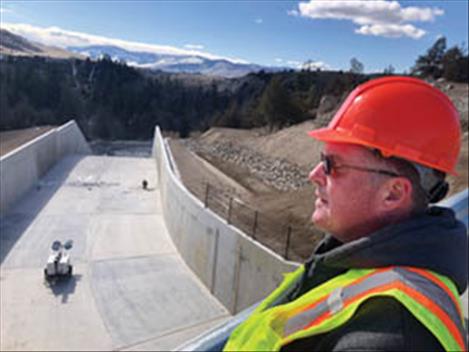Crow Dam spillway project wraps up
Hey savvy news reader! Thanks for choosing local.
You are now reading
1 of 3 free articles.
Weather cooperating, on April 1 detour signs come down, the road traversing Crow Dam southwest of Ronan opens after a two-year closure, and Crow Reservoir will gradually begin to fill again after 16 years of limited storage.
Farmers in the area will no doubt be relieved. Downstream, the reservoir waters the lush Moiese Valley, which grows a mix of alfalfa, potatoes and grain, as well as supplying irrigation to smaller organic farms and livestock operations.
Engineer and Safety of Dams Coordinator Gregory Wilson says weather, a pandemic, challenging terrain and irrigation demands were all factors that made the reconstruction of a spillway on Crow Dam a complex, four-year project.
The 900-foot long earthen dam, constructed in 1933 as part of the sprawling Flathead Indian Irrigation Project (FIIP), was first flagged by engineers in 1996 as “high hazard.” According to a joint report by the Bureau of Indian Affairs and Bureau of Reclamation, if the dam failed it could place the lives of more than 200 people living downstream in danger.
In 2006, restrictions were placed on the dam’s storage capacity due to concerns about its concrete spillway, built 90 years ago to prevent excess water from gushing over the top of the dam, which could cause the impoundment to fail.
“Water flowing over earth is a bad thing where dams are concerned,” says Wilson. Improvements at Crow aim “to protect the public and at the same time retain irrigation water for the season.”
The Bureau of Indian Affairs’ Safety of Dams (SOD) program, administered by the Tribes, has been refurbishing aging dams across the reservation for more than two decades, including impoundments at McDonald Lake and Pablo Reservoir in the Mission Valley and Lower Dry Fork Reservoir near Lone Pine.
Although every dam is unique, “Crow has been our most challenging project so far,” says Wilson.
Crow Dam Road, which cuts across the top of the dam, is a well-used local thoroughfare, linking Round Butte Road to Hwy. 212, west of Charlo. The old spillway tunneled beneath the road.
Phase one of the project, launched in 2018, entailed removing portions of the old spillway on the west side of the dam, constructing the lower spillway structure and adding a stability berm along the dam’s base.
Phase two, begun in 2020, closed the road to through traffic, allowing the contractor to remove the tunnel, build the inlet and upper spillway and then construct a bridge over the top of it all before restoring public access.
As the reservoir rises, water will spill over an impressive looking piano-key weir (so named because the structure, seen from above, resembles a set of piano keys) on the upper spillway, designed to improve flow efficiency.
The two phases cost around $19 million, a sum financed by the federal government through SOD allocations. The contractor is a joint venture between Montana Civil and Big Sky Civil, two construction companies that teamed up to bid this relatively high-dollar project. Over its four-year duration, they’ve employed around 25 tribal and non-tribal laborers – including carpenters, concrete workers and heavy equipment operators.
During a recent visit, crews were putting final touches on the extensive concrete work and area around the spillway. A giant crane removed a light plant, deployed this winter to give crews additional light.
Although water levels will rise this spring, Wilson says filling the impoundment to its brim won’t happen immediately. Engineers need time to evaluate the repairs before allowing the reservoir to fill to capacity.
He also stresses that work remains to be done on Crow Dam. The 90-year-old outlet pipe at the bottom of the reservoir and the gate house at the south end of the dam control stream flows to the creek below. “We’re looking at alternatives on how best to install a new pipe through the base of dam without interfering with the irrigation season,” he says.
He doesn’t anticipate embarking on that project for at least two years.
Meanwhile, the SOD team is forging ahead with other rehab projects, which will be funded in part with money from the Compact Settlement, a complex agreement between the Tribes, state and federal government that resolved water right claims on the Reservation. The $1.9 billion settlement includes funding for rehabilitation of the FIIP storage and delivery system.
Kicking Horse Reservoir, southeast of Ronan, is next on the SOD list. Wilson expects his office will complete design plans this year for removing and replacing the old piping and reducing seepage through the dam and at its foundation.
“We hope to start construction next year without interfering with irrigation,” he says. That’s the challenge on all of these projects, he adds – how to take advantage of Montana’s short construction season while not interrupting irrigation deliveries.
Also on SOD’s horizon are repairs to the outlet works at Mission Dam and Upper Dry Fork Dam, as well as possible modifications to emergency spillways at both sites.
Even with more money available, Wilson acknowledges that finding contractors with the labor force and equipment to tackle these specialized projects is apt to be a challenge. He emphasizes that developing and hiring a pool of local talent is a priority.
CSKT Compact Implementation Officer Rob McDonald views the ongoing construction projects as a boon to the local economy and an opportunity “to illustrate a career path to young people,” ranging from high-paying construction jobs to engineering.
“It’s about finding the next generation and bringing them up to fill these positions,” he adds. “We definitely hope Greg finishes his career with us, and we hope somebody will come up under his mentorship as we move into the future.”
“Until you get your hands dirty, you’ll never know whether you like it or not,” adds Wilson of his line of work.
Construction on the Flathead Indian Irrigation Project, which ferries irrigation water to more than 127,000 acres of land within the boundaries of the Flathead Reservation, began in 1908. A Bureau of Reclamation report, authored in 2001, describes it as “one of the most expansive and intricate of the Indian irrigation efforts,” with 14 dams and reservoirs and more than 1,300 miles of canals and ditches. It’s the largest irrigation project in Montana.
Each project checked off SOD’s list “is another tool in the bag to help with water deliveries, so FIIP overall will benefit,” says McDonald.

















